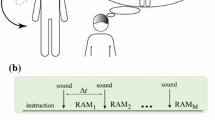Abstract
Movement-related potentials (MRP), a component of the electroencephalogram (EEG) generated during voluntary movements, are known to vary during adaptation to changing loads and to different load types. This study attempts to reveal these changes. A novel denoising algorithm based on iterative approximation was applied to the MRPs recorded from four subjects while performing simple movements against changing loads. The results show that when subjects perform a repetitive task under a constant load there appears a significant peak in the activity of several MRP components recorded over the prefrontal cortex during the third and fourth repetition of the task. Furthermore, different types of loads do not affect the shape of the MRP but different force intensities do.
Similar content being viewed by others
References
L Deeke B Grozinger H Kornhuber (1976) ArticleTitleVoluntary finger movement in man: cerebral potentials and theory Biol Cybern 23 99–119 Occurrence Handle10.1007/BF00336013 Occurrence Handle949512
L Deeke W Becker B Grozinger P Schield H Kornhuber (1993) ArticleTitleHuman brain potentials preceding voluntary limb movements Clin Neurophysiol 33 87–94
G Dirnberger C Duregger G Lindinger W Lang (2004) ArticleTitleHabituation in a simple repetitive motor task: a study with movement-related cortical potentials Clin Neurophysiol 115 IssueID2 378–384 Occurrence Handle10.1016/S1388-2457(03)00328-6 Occurrence Handle14744580
Grossman A (2000) Variations in electro-encephalogram during voluntary finger movements under varying loads. M.Sc. Thesis, Faculty of electrical engineering, Technion Israel Institute of Technology
Haykin S (1995) Adaptive filter theory. Prentice-Hall, Englewood Cliffs, NJ, USA
Y Kita A Mori M Nara (2001) ArticleTitleTwo types of movement-related cortical potentials preceding wrist extension in humans Neuroreport 12 IssueID10 2221–2225 Occurrence Handle10.1097/00001756-200107200-00035 Occurrence Handle11447338
R Kristeva D Cheyene W Lang G Lindinger L Deecke (1990) ArticleTitleMovement-related potentials accompanying unilateral and bilateral finger movements with different inertial loads Clin Neurophysiol 75 IssueID5 410–418 Occurrence Handle10.1016/0013-4694(90)90086-Y
Lange DH, Inbar GF (1999) Modern techniques in ERP research. In: Windhorst U, Johansson H (Eds.) Modern techniques in neuroscience research pp 997–1024.
Makienko I (2002) Estimation of single movement-related brain potential components with changing loads. M.Sc. Thesis, Faculty of electrical engineering, Technion, Israel Institute of Technology
Porat B (1994) Digital processing of random signals. Prentice-Hall, Englewood Cliffs, NJ, USA
O Rompelman HH Ros (1986) ArticleTitleCoherent averaging technique: a tutorial review. part 1: Noise reduction and the equivalent filter J Biomed Eng 8 24–29 Occurrence Handle3951206
DE Rumelhart D Zipser (1985) ArticleTitleFeature discovery by competitive learning Cognit Sci 1 IssueID9 75–112 Occurrence Handle10.1016/S0364-0213(85)80010-0
S Slobounov WJ Ray (1998) ArticleTitleMovement-related potentials with reference to isometric force output in discrete and repetitive tasks Exp Brain Res 123 IssueID4 461–473 Occurrence Handle10.1007/s002210050590 Occurrence Handle9870605
S Slobounov R Tutwiler M Rearick JH Challis (1999) ArticleTitleElectroencephalogram correlates of finger movements with different inertial load conditions as revealed by averaging techniques Clin Neurophysiol 110 IssueID10 1764–1773 Occurrence Handle10.1016/S1388-2457(99)00133-9 Occurrence Handle10574291
S Slobounov M Rearick H Chiang (2000) ArticleTitleElectroencephalogram correlates of finger movements as a function of range of motion and pre-loading conditions Clin Neurophysiol 11 IssueID11 1997–2007 Occurrence Handle10.1016/S1388-2457(00)00432-6
HL Trees Particlevan (1968) Detection estimation and modulation theory Wiley New-York, NY, USA
U Widhorst (1988) How brain-like is the spinal cord Berlin Heidelberg, New York
E Yom-Tov GF Inbar (2000) ArticleTitleMovement related potentials in the human spinal cord preceding toe movements Clin Neurophysiol 11 350–361 Occurrence Handle10.1016/S1388-2457(99)00250-3
E Yom-Tov A Grossman GF Inbar (2001) ArticleTitleMovement-related potentials during the performance of a motor task 2: Cerebral areas activated during learning of the task Biol Cybern 85 387–394 Occurrence Handle10.1007/s004220100264 Occurrence Handle11721992
Author information
Authors and Affiliations
Corresponding author
Rights and permissions
About this article
Cite this article
Makienko, I., Tov, E. & Inbar, G. On the effects of adaptation to changing loads on movement-related EEG potentials. Biol Cybern 93, 171–177 (2005). https://doi.org/10.1007/s00422-005-0573-z
Received:
Accepted:
Published:
Issue Date:
DOI: https://doi.org/10.1007/s00422-005-0573-z




